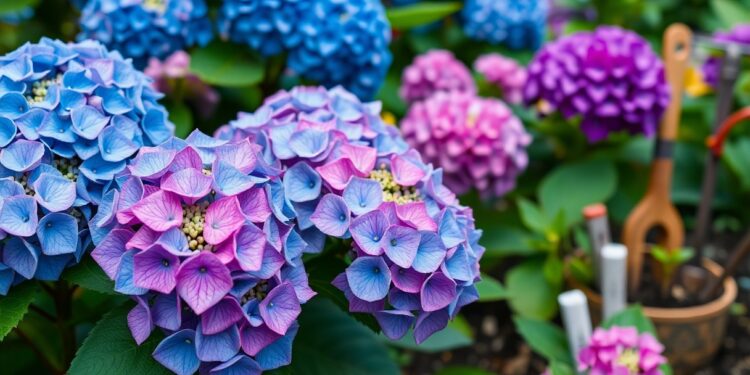This guide will help you transform your hydrangeas into a vibrant display of colors that will make your garden stand out. While pH levels play a significant role in changing their hues, various other factors contribute to their color transformation. From soil composition to nutrient management, you’ll discover tips and tricks that will allow you to enjoy blooming beauties in shades of blue, pink, or even purple. Get ready to dig in and explore how you can influence your hydrangeas’ color and create the garden of your dreams!
Understanding Hydrangea Color
The color of your hydrangeas can be a beautiful reflection of their environment and care. These gorgeous blooms can display hues ranging from soft blues to vibrant pinks, depending on various factors, which makes understanding how you can influence their color so rewarding. By learning what elements come into play, you can better enjoy and possibly change the shades of your hydrangeas to suit your garden’s aesthetic.
The Role of pH
One of the primary factors affecting hydrangea color is soil pH. When the pH level is acidic (below 6.0), your hydrangeas are more likely to present blue blooms. Conversely, a more alkaline soil (above 7.0) often results in pink blooms. It’s crucial to test your soil pH to understand this interplay and make any necessary adjustments to achieve your desired color.
Other Influencing Factors
To create the stunning hydrangea colors you desire, keep in mind that several other factors can influence their hues. These include soil composition, the variety of hydrangea, and even care practices such as watering and fertilizing. Here are some key considerations:
- Soil nutrients: The presence of aluminum can enhance blues.
- Plant variety: Different types of hydrangeas have inherent color properties.
- Seasonal changes: Weather can affect bloom color each year.
After learning about these variables, you can start applying the right techniques to tailor your hydrangea colors.
Other factors that should be evaluated include sunlight exposure and overall plant health. Ensuring your hydrangeas receive the appropriate amount of light and nutrients will contribute to their vibrant colors. Additionally, proper pruning can promote robust blooms. Consider these aspects for a happier, healthier plant:
- Watering routine: Consistent moisture helps maintain color saturation.
- Fertilizer choice: Selecting specialized fertilizers can make a difference.
- Pruning techniques: Timely pruning encourages more blooms on healthy plants.
After considering these details, you’ll be well-equipped to influence your hydrangeas’ stunning colors effectively.
How to Test Your Soil
It’s crucial to understand your soil’s composition before attempting to change your hydrangea color. Testing your soil will give you insight into its pH and nutrient levels, enabling you to make informed decisions on how to amend it for the best results. With just a few simple steps, you can start digging into what your soil has to offer.
Simple Testing Methods
You can easily test your soil at home using a pH test kit, which is available at garden centers or online. Alternatively, you can gather samples and send them to a local extension service for more comprehensive analysis. Both methods will provide valuable information about the needs of your hydrangeas.
Interpreting Your Results
You will need to understand what the results mean to effectively adjust your soil conditions. Checking the pH level will help you determine if your soil is acidic, neutral, or alkaline, guiding you on how to modify it to achieve your desired hydrangea color.
This understanding allows you to tailor your amendments accurately. For example, if your soil is too alkaline and you want blue blooms, you’ll want to add amendments like sulfur or peat moss to lower the pH. On the other hand, if your soil is too acidic and you desire pink flowers, consider adding lime to raise the pH. Knowing your soil’s specifics lets you care for your hydrangeas with confidence!
Adjusting Soil Conditions
Assuming you want to change your hydrangea’s color, adjusting the soil conditions can make a significant difference. Apart from pH, factors like soil structure, moisture, and nutrient levels play important roles in achieving vibrant blooms. By focusing on creating a conducive environment, you can enhance the effects of color-changing amendments, resulting in beautiful hydrangeas that display the shades you desire.
Amending Soil for Color Change
Amending your soil effectively can foster the right conditions for your hydrangeas. Incorporate organic matter like compost or peat moss to improve soil structure and help retain moisture. Additionally, adding materials like sulfur can help lower pH for blue shades, while lime can increase pH for pink hues. Tailored amendments based on your hydrangeas’ needs will encourage vibrant color changes.
Natural Alternatives
Now, if you prefer natural alternatives, there are several options to consider. Using coffee grounds, pine needles, or even tree leaves can naturally lower soil pH, encouraging lovely blue blooms, while crushed eggshells may help raise pH levels for those pink hues. Embracing these organic methods can enhance soil health and provide your hydrangeas with the nutrients they need.
This approach not only helps in achieving the desired color but also enriches your garden’s ecosystem. By utilizing everyday kitchen scraps or yard waste, you’re promoting sustainability and minimizing waste. Plus, these natural amendments can improve soil structure and drainage, creating an ideal environment for your hydrangeas to flourish, all while being eco-friendly and gentle on your garden.
Caring for Your Hydrangeas
All hydrangeas thrive with the right care, so it’s imperative to provide them with the attention they need to bloom beautifully. Regular watering, proper fertilization, and ensuring they have the right amount of sunlight will keep your plants healthy and vibrant. Taking the time to understand their specific needs will enhance their color and overall growth, allowing you to enjoy their stunning display all season long.
Watering Tips for Color
Little adjustments in your watering routine can significantly impact your hydrangeas’ color. Aim for consistent moisture levels, especially during dry periods. Here are some tips to consider:
- Water deeply but infrequently.
- Use mulch to retain soil moisture.
- Check soil moisture before watering.
Assume that your hydrangeas may need extra water during blooming to support those gorgeous blooms!
Fertilization Practices
Color is largely influenced by the nutrients you provide through fertilization. Ensuring your hydrangeas receive the right balance can enhance their vibrancy and health.
Practices like using a balanced, slow-release fertilizer in early spring will set your hydrangeas up for success. A fertilizer that promotes blooms will be most beneficial. Additionally, consider adding compost for extra nutrients throughout the growing season. Keep an eye on the nitrogen levels, as high nitrogen can lead to lush foliage at the expense of flowers. A little extra care in fertilization can lead to stunning, colorful blooms in your garden!
Seasonal Considerations
For your hydrangeas, the changing seasons can greatly influence their color potential. Each season brings different nutrient availability and temperatures, which can impact how your plants absorb elements from the soil and affect their overall health. By understanding these seasonal effects, you can take the right steps to ensure vibrant blooms that reflect your desired shades.
Best Time to Change Color
Change the color of your hydrangeas in early spring or late summer when the plants are actively growing. This is the ideal time to adjust soil pH or introduce nutrients to help your blooms transition into those beautiful hues you desire. Timing is key, as it allows the plants to respond positively before the next blooming phase.
Impact of Weather Patterns
The weather can play a significant role in the color of your hydrangeas. Factors like extreme heat, heavy rainfall, or prolonged drought can influence soil conditions and plant stress, ultimately affecting their pigmentation.
For instance, during unusually hot summers, your hydrangeas may struggle to absorb nutrients, leading to washed-out colors. On the other hand, excessive rain can leach vital minerals from the soil, causing your blooms to be less vibrant. Monitoring weather patterns and adapting your care routine can help you achieve those stunning colors you’re aiming for.
Troubleshooting Common Issues
Keep an eye on your hydrangeas for signs that they may not be changing color as expected. Factors like soil type, water quality, and even weather conditions can affect their ability to reach their full color potential. It’s important to diagnose the underlying issue to ensure your hydrangeas thrive.
What If Colors Don’t Change?
On the off chance that your hydrangea colors remain unchanged despite your efforts, reassess the soil conditions and make sure you’re using the right amendments. Factors like age and variety also play a significant role, so don’t be too disheartened; patience is key!
Tips for Healthy Hydrangeas
With a few simple care tips, you can promote healthy growth in your hydrangeas. Regular watering, adequate sunlight, and proper pruning can make all the difference. Here are some tips:
- Provide consistent watering without over-saturating
- Ensure they have plenty of morning sunlight
- Prune after blooming for more vibrant blooms next season
Perceiving care as a continuous journey will help your plants flourish.
Understanding the specific needs of your hydrangeas will also enhance their health and beauty. Tailoring your care to the variety and environmental conditions can lead to stunning results. Make sure to:
- Test your soil regularly
- Add organic matter for better drainage
- Watch out for pests and diseases
Perceiving these elements as important will promote vibrant, healthy blooms in your garden.
Summing up
So, as you explore ways to change your hydrangea color, keep in mind that while pH is a factor, it’s not the only one. Factors like soil composition, nutrient availability, and even the variety of hydrangea you choose can all influence the hues of your blooms. By experimenting with these elements, you’ll discover the perfect combination to achieve the vibrant colors you desire. Happy gardening!

















